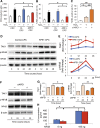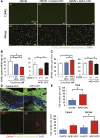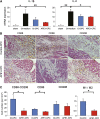Apoptosis-Resistant Cardiac Progenitor Cells Modified With Apurinic/Apyrimidinic Endonuclease/Redox Factor 1 Gene Overexpression Regulate Cardiac Repair After Myocardial Infarction
- PMID: 27334489
- PMCID: PMC4954451
- DOI: 10.5966/sctm.2015-0281
Apoptosis-Resistant Cardiac Progenitor Cells Modified With Apurinic/Apyrimidinic Endonuclease/Redox Factor 1 Gene Overexpression Regulate Cardiac Repair After Myocardial Infarction
Abstract
: Overcoming the insufficient survival of cell grafts is an essential objective in cell-based therapy. Apurinic/apyrimidinic endonuclease/redox factor 1 (APE1) promotes cell survival and may enhance the therapeutic effect of engrafted cells. The aim of this study is to determine whether APE1 overexpression in cardiac progenitor cells (CPCs) could ameliorate the efficiency of cell-based therapy. CPCs isolated from 8- to 10-week-old C57BL/6 mouse hearts were infected with retrovirus harboring APE1-DsRed (APE1-CPC) or a DsRed control (control-CPC). Oxidative stress-induced apoptosis was then assessed in APE1-CPCs, control-CPCs, and neonatal rat ventricular myocytes (NRVMs) cocultured with these CPCs. This analysis revealed that APE1 overexpression inhibited CPC apoptosis with activation of transforming growth factor β-activated kinase 1 (TAK1) and nuclear factor (NF)-κB. In the coculture model, NRVM apoptosis was inhibited to a greater extent in the presence of APE1-CPCs compared with control-CPCs. Moreover, the number of surviving DsRed-positive CPC grafts was significantly higher 7 days after the transplant of APE1-CPCs into a mouse myocardial infarction model, and the left ventricular ejection fraction showed greater improvement with attenuation of fibrosis 28 days after the transplant of APE1-CPCs compared with control-CPCs. Additionally, fewer inflammatory macrophages and a higher percentage of cardiac α-sarcomeric actinin-positive CPC-grafts were observed in mice injected with APE1-CPCs compared with control-CPCs after 7 days. In conclusion, antiapoptotic APE1-CPC graft, which increased TAK1-NF-κB pathway activation, survived effectively in the ischemic heart, restored cardiac function, and reduced cardiac inflammation and fibrosis. APE1 overexpression in CPCs may serve as a novel strategy to improve cardiac cell therapy.
Significance: Improving the survival of cell grafts is essential to maximize the efficacy of cell therapy. The authors investigated the role of APE1 in CPCs under ischemic conditions and evaluated the therapeutic efficacy of transplanted APE1-overexpressing CPCs in a mouse model of myocardial infarction. APE1 hindered apoptosis in CPC grafts subjected to oxidative stress caused in part by increased TAK1-NF-κB pathway activation. Furthermore, APE1-CPC grafts that effectively survived in the ischemic heart restored cardiac function and attenuated fibrosis through pleiotropic mechanisms that remain to be characterized. These findings suggest that APE1 overexpression in CPCs may be a novel strategy to reinforce cardiac cell therapy.
Keywords: Apoptosis; Cellular therapy; Gene expression; Sca-1; Stem/progenitor cell.
©AlphaMed Press.
Figures






Similar articles
-
Irisin promotes cardiac progenitor cell-induced myocardial repair and functional improvement in infarcted heart.J Cell Physiol. 2019 Feb;234(2):1671-1681. doi: 10.1002/jcp.27037. Epub 2018 Sep 1. J Cell Physiol. 2019. PMID: 30171682 Free PMC article.
-
Specific inhibition of HDAC4 in cardiac progenitor cells enhances myocardial repairs.Am J Physiol Cell Physiol. 2014 Aug 15;307(4):C358-72. doi: 10.1152/ajpcell.00187.2013. Epub 2014 Jun 18. Am J Physiol Cell Physiol. 2014. PMID: 24944198 Free PMC article.
-
Sca-1+ cardiac progenitor cell therapy with cells overexpressing integrin-linked kinase improves cardiac function after myocardial infarction.Transplantation. 2013 May 27;95(10):1187-96. doi: 10.1097/TP.0b013e31828a9423. Transplantation. 2013. PMID: 23598943
-
Cardiac Progenitor-Cell Derived Exosomes as Cell-Free Therapeutic for Cardiac Repair.Adv Exp Med Biol. 2017;998:207-219. doi: 10.1007/978-981-10-4397-0_14. Adv Exp Med Biol. 2017. PMID: 28936742 Review.
-
Concise Review: Reduction of Adverse Cardiac Scarring Facilitates Pluripotent Stem Cell-Based Therapy for Myocardial Infarction.Stem Cells. 2019 Jul;37(7):844-854. doi: 10.1002/stem.3009. Epub 2019 Apr 6. Stem Cells. 2019. PMID: 30913336 Free PMC article. Review.
Cited by
-
The role of reactive oxygen species in the pathophysiology of cardiovascular diseases and the clinical significance of myocardial redox.Ann Transl Med. 2017 Aug;5(16):326. doi: 10.21037/atm.2017.06.27. Ann Transl Med. 2017. PMID: 28861423 Free PMC article. Review.
-
Enalapril attenuates endoplasmic reticulum stress and mitochondrial injury induced by myocardial infarction via activation of the TAK1/NFAT pathway in mice.Exp Ther Med. 2020 Feb;19(2):972-980. doi: 10.3892/etm.2019.8280. Epub 2019 Dec 4. Exp Ther Med. 2020. PMID: 32010259 Free PMC article.
-
From DNA Repair to Redox Signaling: The Multifaceted Role of APEX1 (Apurinic/Apyrimidinic Endonuclease 1) in Cardiovascular Health and Disease.Int J Mol Sci. 2025 Mar 26;26(7):3034. doi: 10.3390/ijms26073034. Int J Mol Sci. 2025. PMID: 40243693 Free PMC article. Review.
-
Therapeutic Strategies for Regulating Mitochondrial Oxidative Stress.Biomolecules. 2020 Jan 5;10(1):83. doi: 10.3390/biom10010083. Biomolecules. 2020. PMID: 31948035 Free PMC article. Review.
-
Association between apurinic/apyrimidinic endonuclease 1 rs1760944 T>G polymorphism and susceptibility of cancer: a meta-analysis involving 21764 subjects.Biosci Rep. 2019 Dec 20;39(12):BSR20190866. doi: 10.1042/BSR20190866. Biosci Rep. 2019. PMID: 31804681 Free PMC article.
References
-
- Assmus B, Honold J, Schächinger V, et al. Transcoronary transplantation of progenitor cells after myocardial infarction. N Engl J Med. 2006;355:1222–1232. - PubMed
-
- Stamm C, Kleine HD, Choi YH, et al. Intramyocardial delivery of CD133+ bone marrow cells and coronary artery bypass grafting for chronic ischemic heart disease: Safety and efficacy studies. J Thorac Cardiovasc Surg. 2007;133:717–725. - PubMed
-
- Menasché P, Alfieri O, Janssens S, et al. The Myoblast Autologous Grafting in Ischemic Cardiomyopathy (MAGIC) trial: First randomized placebo-controlled study of myoblast transplantation. Circulation. 2008;117:1189–1200. - PubMed
Publication types
MeSH terms
Substances
LinkOut - more resources
Full Text Sources
Other Literature Sources
Medical
Research Materials
Miscellaneous

